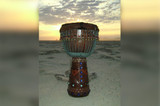Drummer Health and Wellness
Drumming and rhythm continues to find a path in the world of exercise and fitness. From group exercise that includes rhythm and drums, to the simple act of plugging into some music while working out, drumming reaches beyond motivation and can benefit the brain as well as the body.
For the drummer, drumming itself is a form of exercise that can combine the best of all worlds. But, like any aerobic or cardiovascular activity, drumming also comes with the potential for injury to the drummer. Long drumming sessions on a Djembe, bongos or full drum set are full of health and wellness benefits, but it is also these marathons of rhythm that can cause repetitive stress injuries to the neck, back, arms, wrists or hands. Preventing or reducing these types of injuries is possible when the drummer properly warms up the muscles, takes breaks and practices proper drumming postures. Warming up before drumming not only helps prepare the body for drumming, but it can also improve the drumming activity itself.
Some drumming injuries can occur from the drums or equipment itself. Hand drummers can be injured by the edges of the drums while playing rim shots, or can run the risk of cracked skin or blisters. Heavy drums that are strapped to the drummer can cause pain when played for lengthy durations, especially if the height of the drum, such as a Djembe or Conga drum, is not appropriately sized to the drummer. By adjusting the strap, even an inch or two, much of the fatigue felt why drumming can be relieved. This same practice is true for drums that are affixed to stands and hardware, and it is vital that the drummer plays a drum that is fixed at the right height for maximum comfort.
The best drumming comes from a drummer who is aware of the physical toll it can take on the body. While drumming is a great exercise for the mind, body and creativity, learning to prepare for drumming can make these effects even more beneficial for both the drummer and the audience. Warm up, stretch, sit or stand properly and be sure to adjust all equipment, stands and straps, and let the rhythm continue to beat away the stress and strain of the day.
Recent Posts
-
What is the Best Size Djembe for Beginners?
If you're new to the world of percussion and interested in learning the djembe, you're in for a t …16th Jul 2024 -
The Benefits of Becoming a Drumming Teacher: Transforming Passion into Profession
Why become a drumming teacher? Becoming a drumming teacher is an excellent way to share your pas …22nd May 2024 -
What Makes the Djembe Drum a Spiritual Instrument in African Music?
Origin and history of the Djembe drum The Djembe drum originates from West Africa and holds sign …16th May 2024



